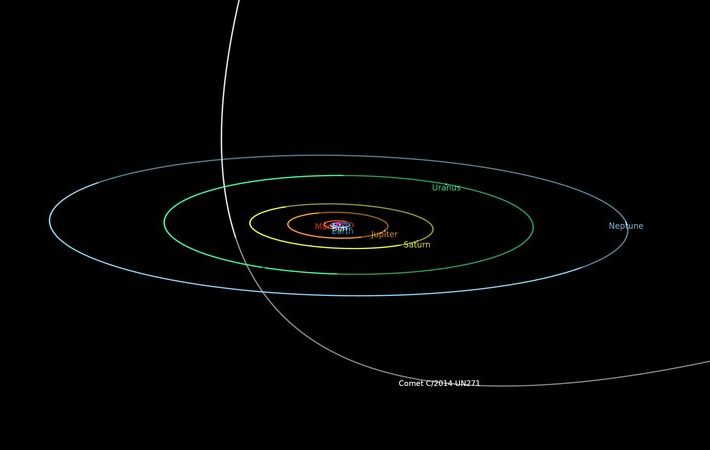A giant comet found far out in the solar system may be 1,000 times more massive than a typical comet, making it potentially the largest ever found in modern times.
Written content from Elizabeth Howell

The object, officially designated a comet on June 23, is called Comet C/2014 UN271 or Bernardinelli-Bernstein after its discoverers, University of Pennsylvania graduate student Pedro Bernardinelli and astronomer Gary Bernstein.
Astronomers estimate this icy body has a diameter of 62 miles to 124 miles (100 to 200 km), making it about 10 times wider than a typical comet. This estimate is quite rough, however, as the comet remains far away from Earth and its size was calculated based on how much sunlight it reflects. The comet will make its closest approach to our planet in 2031 but will remain at quite a distance even then.
“We have the privilege of having discovered perhaps the largest comet ever seen — or at least larger than any well-studied one — and caught it early enough for people to watch it evolve as it approaches and warms up,” Bernstein said in a June 25 statement from the National Science Foundation’s National Optical-Infrared Astronomy Research Laboratory, or NOIRLab.
First spotted in archival images from the Dark Energy Survey taken in 2014, Comet Bernardinelli-Bernstein is now located at the equivalent distance of Uranus, roughly 20 astronomical units (AU) from the sun. (One AU is the Earth-sun distance — about 93 million miles, or 150 million kilometers). The comet shines at magnitude 20, making it out of reach of most amateur astronomers’ telescopes; by comparison, most people can see objects of magnitude 5 or 6 with the naked eye in dark conditions.
When the comet swings closer to Earth in 2031, it will still be at 11 AU, which is a little more distant than Saturn’s average orbit from the sun. Even then, amateur skywatchers will still need to use very large telescopes to see it, NSF stated.
What makes Comet Bernardinelli-Bernstein so special, aside from its size, is the fact it hasn’t visited the inner solar system in three million years, roughly the same era that the famous human ancestor “Lucy” was walking the Earth. The comet originated some 40,000 AU away from the sun in the Oort Cloud, which is a huge, distant region of space thought to hold trillions of comets.
The comet popped up during a scan of archival images of the Dark Energy Survey, which uses a wide-field 570-megapixel CCD imager mounted on the Víctor M. Blanco 4-meter telescope at Cerro Tololo Inter-American Observatory in Chile. The survey’s main goal is mapping 300 million galaxies across a swath of the night sky, but its deep-sky observations have also yielded several comets and trans-Neptunian objects (TNOs), which are icy worlds orbiting beyond Neptune.
Bernardinelli and Bernstein spotted the comet using the National Center for Supercomputing Applications and Fermilab, identifying 800 TNOs from archival survey data. While the images of the comet didn’t show a classic tail between 2014 and 2018, an independent observation from the Las Cumbres Observatory network in 2021 (after the comet’s existence was made public) showed the comet now has a coma of gas and dust surrounding it. Read more from Space





